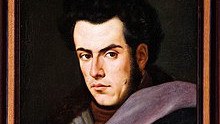Ciro Menotti, Italian patriot (1798-1831)
He was fascinated by the new approach of King Louis Phillipe of Orléans and from 1820 was constantly in touch with French liberal circles: the objective was to liberate the Duchy of Modena from the yoke of Austria.
Modena was then governed by Francis IV of Hapsburg-Este, the Archduke of Austria.
He considered the Duchy of Modena far too small for his ambitions, cultivated diplomatic relationships with many different European states and maintained a sumptuous court. This explains his attitude towards the revolutionary movements agitating Italy at the time; on the one hand, he feared and obstructed them; yet, on the other, he encouraged them in the hope they could be turned to his own personal advantage.
After first meeting Menotti, Francis IV initially did not react to the revolutionary project: perhaps there were precise agreements between the two, even through another liberal figure - lawyer Enrico Misley, who was a frequent guest of the ducal court.
January 1831 saw Menotti organise an uprising in great detail. On 3 February, he brought together about 40 conspirators in his home, not far from the Ducal Palace, to organise the revolt.
Francesco IV, in any case, with a sudden about-turn undoubtedly imposed on him by the Austrian government, decided to withdraw his support for Menotti's cause and sent troops to surround Menotti's house; the conspirators tried to flee - some escaped, others did not - and these included Ciro Menotti himself, who was injured after jumping from a window into the garden behind his home, captured and imprisoned. The Duke, frightened by the riots also breaking out in Bologna, sought refuge in Mantua and took Menotti with him.
On the failure of the insurrections, the Duke returned to Modena, again taking Menotti with him as a prisoner.
Two months later, the trial was held which culminated in a death sentence by hanging. Menotti passed the night before the execution (23 May 1831) with a priest to whom he gave a truly noble letter for his wife.
Today n° 90 in Corso Canal Grande, where he lived, has a commemorative plaque. Nor should one forget the monument, commissioned by the people of Modena and carved by sculptor Cesare Sighinolfi, also from Modena. It was erected in 1879 precisely opposite the entrance to the Ducal Palace. The patriot is portrayed looking towards the room where his death sentence was signed that, at the time of the dukes, was the centre of power.
The block where Menotti and Borelli were executed by hanging was also restored recently. The work in bare stone is located in Piazza I Maggio and includes several steps of the gallows; it is surrounded and illuminated by white, red and green spotlights.
Ciro Menotti is buried in the family tomb in Spezzano cemetery, Modena.





